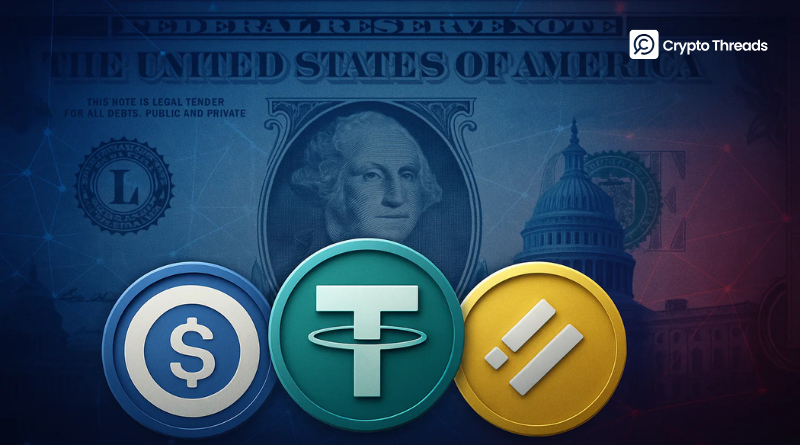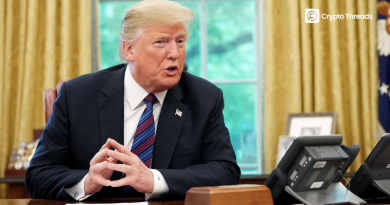US Stablecoin Market Hits $1.5T Record in July 2025
Key Takeaways:
- Stablecoin on-chain volume hit a record $1.5 trillion in July 2025, up from $1.26 trillion in June.
- USDC led the market with $748 billion in transactions, followed by USDT ($420B) and DAI ($261B).
- The spike came after the GENIUS Act was signed into law, creating the first stablecoin regulatory framework in the U.S.
- Bitcoin and Ethereum’s price rally drove investors to rotate profits into stablecoins.
- Institutions like JPMorgan and Meta are exploring stablecoin use cases.
- Total stablecoin market capitalization now exceeds $278 billion.
Regulatory clarity, bullish market activity, and institutional exploration push stablecoins into the spotlight
The U.S. stablecoin market achieved a major milestone in July 2025, with on-chain transaction volume surpassing $1.5 trillion, setting a new all-time high for the sector. This figure, reported by Sentora (formerly IntoTheBlock), marks a significant jump from $1.26 trillion in June and exceeds the previous record of $1.4 trillion set in August 2024.
This surge is not the result of a single trend but rather the outcome of three converging forces: a bullish crypto market, a breakthrough in stablecoin regulation, and a sharp increase in institutional adoption.
USDC Leads the Surge, Followed by USDT and DAI
A deeper look at the July figures reveals that Circle’s USDC emerged as the dominant stablecoin, accounting for nearly 50% of the total transaction volume. In monetary terms, USDC processed around $748 billion in on-chain activity throughout the month.
Meanwhile, Tether’s USDT, which still holds the largest circulating supply among stablecoins, posted $420 billion in volume. The decentralized stablecoin DAI, backed by Ethereum-based collateral, followed with $261 billion in total transactions.
This distribution indicates that while centralized stablecoins remain in high demand, decentralized alternatives are also gaining traction, especially among users seeking censorship resistance and transparency.
Why Stablecoin Volume Spiked in July
Several key factors contributed to the July spike in stablecoin activity:
First, the crypto market saw extraordinary price performance during the month. Bitcoin reached a new all-time high of over $123,000, while Ethereum climbed toward the $4,000 mark. These record levels triggered profit-taking among investors, who rotated capital into non-volatile assets like USDC and USDT. This behavior reflects a familiar pattern: when major cryptocurrencies rally, stablecoin activity also increases as users move funds for hedging, yield farming, and capital preservation.
Second, and perhaps most crucially, was the passage of the GENIUS Act on July 19, 2025. This legislation is the first comprehensive stablecoin regulation in the United States, establishing clear rules around reserve backing, transparency, and oversight.
Under the GENIUS Act, all fiat-backed stablecoins must maintain 1:1 reserves, be subject to audits, and operate under the supervision of the Federal Reserve. These provisions aim to prevent systemic risks, increase public trust, and provide legal certainty for businesses operating in the space.
The approval of this bill sent a strong signal to the market. It removed a major source of regulatory uncertainty that had been looming over stablecoins for years and opened the door for broader institutional participation.
Institutions Step In: From Wall Street to Silicon Valley
With a clearer regulatory framework in place, several major institutions have started exploring stablecoin integration into their financial infrastructure.
JPMorgan, for example, has reportedly accelerated internal testing of USDC for cross-border payments. Meanwhile, Meta is evaluating stablecoin solutions for use in its messaging and payment platforms, viewing them as a bridge between Web2 and Web3 finance.
This wave of institutional exploration is particularly noteworthy because it signals that stablecoins are evolving beyond the crypto-native community. Their use cases now span international remittances, B2B settlements, and on-chain financial products, offering efficiency advantages over traditional systems.
According to CryptoSlate, the total market capitalization of all stablecoins has now risen above $278 billion, reflecting both investor confidence and increased usage across decentralized and traditional finance.
Conclusion: A New Era for Stablecoins
The combination of a favorable regulatory environment, rising utility, and strong market demand has pushed stablecoins into a new era of growth. July’s record-breaking $1.5 trillion volume may not be a one-off spike, it could represent the beginning of a sustained upward trajectory.
As U.S. lawmakers continue to provide legal clarity, and more institutions build around digital dollars, stablecoins are rapidly transitioning from crypto tools to mainstream financial infrastructure.



